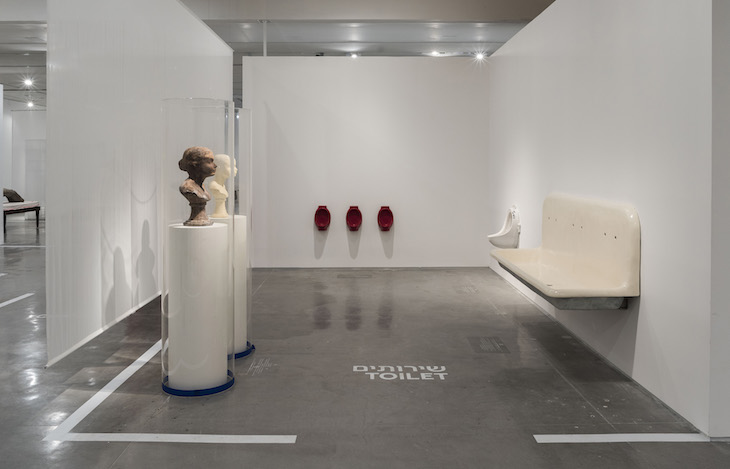It is a kitchen unlike any other: a cheese grater stands two metres tall, the stove doubles as a wearable apron, offering fresh bread from the womb, and vinyl sandwiches sit beside a beer mug sprouting a tail. In the background, flickering on a small black and white television set, a woman holds court – the domestic goddess, illustrating the alphabet with a set of utensils.
The kitchen, of course, is not for cooking – it’s for looking. The cheese grater is Mona Hatoum’s sculpture Grater Divide (2002); the Stove Apron designed by Birgit Jürgenssen in the mid 1970s; the lunch box and beer mug conceived by Claes Oldenburg (1962) and Meret Oppenheim (1960), respectively. And the woman presiding over it all is not a cooking host but artist Martha Rosler, performing her 1975 performance parody piece Semiotics of the Kitchen. It’s one of the most engaging rooms in the Israel Museum’s expansive investigation of Dada, Surrealism and domestic space in the exhibition ‘No Place Like Home’.
Installation view of ‘No Place Like Home’ at the Israel Museum, showing Mona Hatoum’s Grater Divide (2002). Image: courtesy Israel Museum, Jerusalem

Art historically, this is well-trodden territory: how has the home, and the everyday objects that decorate it, informed the timeline of 20th-century art? But Adina Kamien-Kazhdan, the museum’s curator of modern art, has packaged the exhibition in her own inspired way – a house tour decorated with some of Dada and Surrealism’s biggest names, and the work of their successors.
Kamien-Kazhdan may have had a little help from IKEA in deciding on this particular layout – the Swedish home furnishing company’s Israeli branch is one of the exhibition’s primary sponsors. Complete with a room-by-room floor plan outlined in vinyl, and a catalogue that resembles one used to sell furniture, the exhibition leaves visitors free to wander the museum’s faux home showroom. Gimmicky? Perhaps. But the overall effect is one of experimental quirk, a nod to the artwork that inspired it.
Installation view of ‘No Place Like Home’ at the Israel Museum, showing a 1964 editioned replica of Duchamp’s Fountain. Image: courtesy Israel Museum, Jerusalem

In a way, ‘No Place Like Home’ begins not in the foyer, but in the toilet. Looking back to 1917, the exhibition was conceived as a centenary celebration of Marcel Duchamp’s decision to tip a urinal on its head and call it ‘art’. A 1964 editioned replica of the seminal readymade, Fountain, hangs on the wall of the exhibition’s ‘toilet’, but this time, its orientation is as the manufacturer originally intended.
From here, bigger questions come into play: questions of authorship, mass production, mass consumption, recontextualisation, gender politics and cultural identity. How does the public world affect the private realm of the home? And who controls what goes on inside of one? Like a trip to IKEA, there’s so much to think about, it verges on overwhelming – but that’s very much the point. As the wall text puts it, the walkthrough is a domestic experience ‘at once familiar and disorienting’.
Installation view of ‘No Place Like Home’ at the Israel Museum, showing Andy Warhol’s Brillo Box (1964) and Yayoi Kusama’s Untitled (Ironing Board) (1963). Image: courtesy Israel Museum, Jerusalem

Over 70 of the 120 artworks on display were already in their own home. The Israel Museum dipped into its rich collection of Surrealist art, a primary focus of its modern holdings since Arturo Schwarz’s donation of 13 Duchamp readymades in 1972. Older works in this vein anchor the show: a dozen Duchamps are dotted throughout; the utility room houses Man Ray’s 1920 blanket-wrapped sewing machine, Enigma of Isidore Ducasse (here an editioned replica from 1971); above it, Andy Warhol’s 1964 Brillo Box sits on a shelf.
These are the kinds of names often on display in a museum’s permanent collection – incredible, but expected. In ‘No Place Like Home’, the old favourites are actually eclipsed by feminist or contemporary installations. Back in the utility room, Yayoi Kusama’s Untitled (Ironing Board) (1963), erupting with hundreds of stuffed, white penises, provides defiant counter to the men displayed on the shelves across the way. In the bedroom, Louise Bourgeois’ Arched Figure (1993) touches on the erotic and the intimate; next door, in the dressing room, Sarah Lucas’ Cigarette Tits (1999) treads an absurd line between pleasure and death.
Installation view of ‘No Place Like Home’ at the Israel Museum, showing Louise Bourgeois’ Arched Figure (1993). Image: courtesy Israel Museum, Jerusalem

Down the corridor, the children’s room is a contemporary funhouse, complete with a Sherrie Levine rocking horse (Dada; 2008) and Takashi Murakami Mr. DOB balloon (1994) hovering in the corner. Towards the end of the exhibition, a lone wooden structure, shaped like a human-sized metronome stands in front of the ‘garage’. Commissioned specifically for ‘No Place Like Home’, Ben Gitai constructed his interpretation of the ‘mamad’ or security room that, since 1992, every Israeli residence is legally required to configure into its architecture. Here, the outside world creeps back into the exhibition – a reminder of the region’s conflict before heading back into reality.
Installation view of ‘No Place Like Home’ at the Israel Museum, showing Takashi Murakami’s Mr. DOB balloon (1994). Image: courtesy Israel Museum, Jerusalem

In the exhibition’s catalogue essay, Esther Sperber asks: What is a home? Is it a place or an idea? Is our home the destination we yearn for on a long journey, or the childhood origin from which we travel? The answer, of course, is all of these things and, as illustrated by the many artists in this faux-home, so much more.
‘No Place Like Home’ is at the Israel Museum, Jerusalem, until 29 July 2017.



